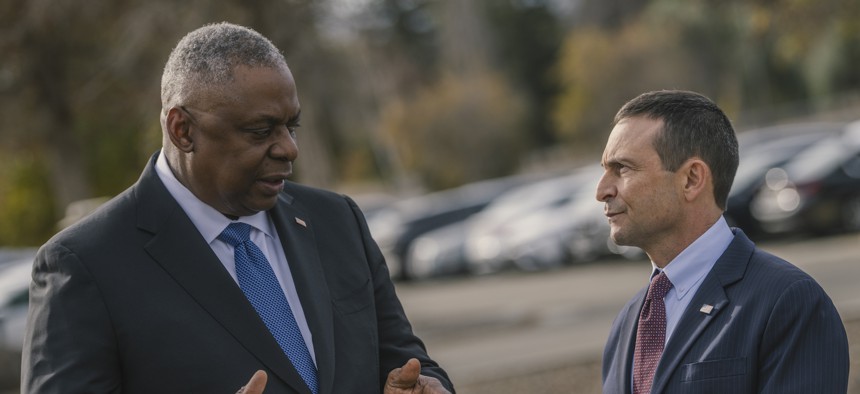Defense innovation Unit looks to scale up in new phase

DIU Director Doug Beck in conversation with Defense Secretary Lloyd Austin at Moffet Field, California in December 2023. DOD photo by Chad J. McNeeley
The director of the Defense Innovation Unit said the new strategy places a greater focus on helping the Pentagon “leverage the best of commercial technology and innovation at speed and scale.”
The Pentagon’s hub for accelerating the adoption of commercial technologies for battlefield use is entering “a new phase” of work that will focus on quickly addressing gaps in the U.S. military’s capabilities, according to the head of the unit.
In a report released on Wednesday by the Center for a New American Security, Doug Beck — director of the Defense Innovation Unit, or DIU — outlined a new strategy that, he wrote, will better position the Department of Defense to meet the pacing challenge posed by China and other global adversaries in fielding critical emerging technologies that are “proceeding at a much faster rate in the private sector than in the traditional defense sector.”
To better tap into the private sector’s advancements in emerging technologies, including artificial intelligence and biotechnology, Beck said the new strategy — dubbed DIU 3.0 — will build upon the organization’s previous work helping the Pentagon “achieve critical objectives in cooperation with allies and partners, and across all warfighting domains.”
The new plan, approved by Defense Secretary Lloyd Austin, will focus on ensuring the Pentagon “can leverage the best of commercial technology and innovation at speed and scale to deter major conflict or win if forced to fight.”
The DIU 3.0 strategy outlines “eight mutually reinforcing lines-of-effort,” with the leading action directing the unit to “focus on the most critical capability gaps and embed with the warfighter to do so.”
In addition to deepening the unit’s “embedded support” for U.S. European Command and U.S. Indo-Pacific Command, Beck wrote that DIU will also embed personnel “at the most critical nodes of warfighter demand, within the most innovative operating organizations of the Joint Force and at the key points of innovative warfighter demand in each of the services and the special operations community.”
Additional steps outlined in the new strategy include strengthening partnerships across DOD; bringing the Pentagon’s “innovation entities into a community of impact;” bolstering partnerships with commercial tech companies, allies and partners; and working to “build the trust and momentum required for speed and scale.”
DIU 3.0 also highlights the need to enhance the unit’s staff and leadership to place more of an emphasis on quickly adopting new technologies. Beck noted that Austin has already approved plans to increase the size of the organization’s workforce, as well as bringing on board two senior executive deputy directors based at the Pentagon to help lead its efforts.
Beck noted in the report that the same day he took over as DIU’s new director last April, the Pentagon elevated the unit to report directly to Defense Secretary Austin. He said Austin’s move was “a reflection of the central role that commercially derived technologies must play in the department's efforts to counter the pacing challenge of the [People's Republic of China], meet the acute threat from Russia and simultaneously address other threats across the globe.”
Beck said DIU 3.0 is poised to take advantage of this restructuring by positioning the organization “at the intersection of two worlds,” allowing it to serve as a more effective conduit between government and the private sector.
“The imperative for DIU 3.0 is clear,” he wrote. “Against a backdrop of international challenges and with the world’s most capable technology sector, we can and must do more to identify and adopt impactful commercial technologies at speed and scale.”






